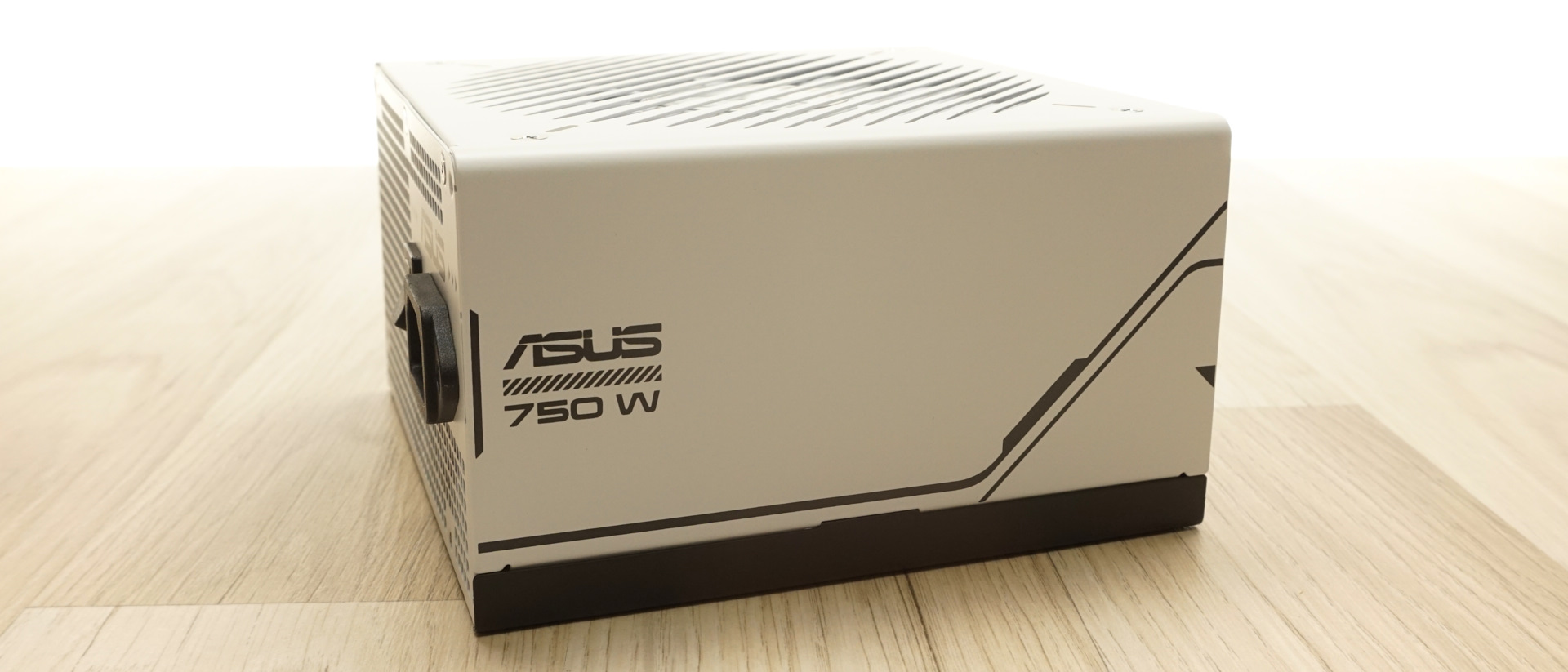Tom's Hardware Verdict
The Asus Prime AP-750G Gold 750W PSU offers solid performance and efficiency for its price, but its component quality and ripple suppression fall short of premium standards. A decent value for budget-conscious users.
Pros
- +
Good price-to-performance ratio
- +
Efficient, easily meeting 80Plus Gold
- +
Quiet operation at low and medium loads
- +
Long, 8-year warranty
- +
Attractive dual-tone design
Cons
- -
Average ripple suppression
- -
Component quality could improve
Why you can trust Tom's Hardware
Asus is a prominent Taiwanese multinational technology company, founded in 1989, that specializes in the production of computer hardware and consumer electronics. It began with a focus primarily on PC motherboards and slowly diversified into other segments of the PC market. Today, the company's primary business activities include manufacturing motherboards, graphics cards, laptops, desktops, and other PC hardware and peripherals. Asus is also well-known for its high-performance gaming products under the ROG (Republic of Gamers) brand.
Asus diversified into the power supply unit (PSU) market in 2017, when it released its first PC PSUs, offering reliable and efficient power solutions aimed at both gaming enthusiasts and professional users. Today, Asus is offering three PSU series : Prime, TUF Gaming, and ROG Gaming. In this review we are having a look at the least expensive of the three, the Prime series and specifically the Asus Prime AP-750G. The AP-750G is, as its name suggest, a 750W power supply unit with an 80Plus Gold certification. It complies with the ATX 3.0 requirements and features a unique dual-tone aesthetic design. Priced at $100, it comes with an 8-year warranty and aims to balance performance, aesthetics, and cost-effectiveness for various PC builds.
Specifications and Design
| RAIL | +3.3V | +5V | +12V | +5Vsb | -12V |
| MAX OUTPUT | 20A | 20A | 62A | 2.5A | 0.3A |
| Row 2 - Cell 0 | 110W | 110W | 744W | 12.5W | 3.6W |
| TOTAL | 750W | 750W | 750W | 750W | 750W |
| AC INPUT | 100 - 240 VAC, 50 - 60 Hz | 100 - 240 VAC, 50 - 60 Hz | 1100 - 240 VAC, 50 - 60 Hz | 100 - 240 VAC, 50 - 60 Hz | 100 - 240 VAC, 50 - 60 Hz |
| MSRP | $100 | Row 5 - Cell 2 | Row 5 - Cell 3 | Row 5 - Cell 4 | Row 5 - Cell 5 |
In the Box
The Asus Prime AP-750G Gold 750W PSU is designed with all-black cables, including both the connectors and wires, which contribute to a clean and cohesive appearance. The cables are of the ribbon-line, "flat" variety, without any nylon sleeving. This unit has one 12VHPWR connector and three PCI Express 6+2 pin connectors, with two of the PCI Express connectors sharing a single cable.
| Connector type | Hardwired | Modular |
|---|---|---|
| ATX 24 Pin | - | 1 |
| EPS 4+4 Pin | - | 2 |
| EPS 8 Pin | - | - |
| PCI-E 5.0 | - | 1 |
| PCI-E 8 Pin | - | 3 |
| SATA | - | 5 |
| Molex | - | 3 |
| Floppy | - | - |
External Appearance





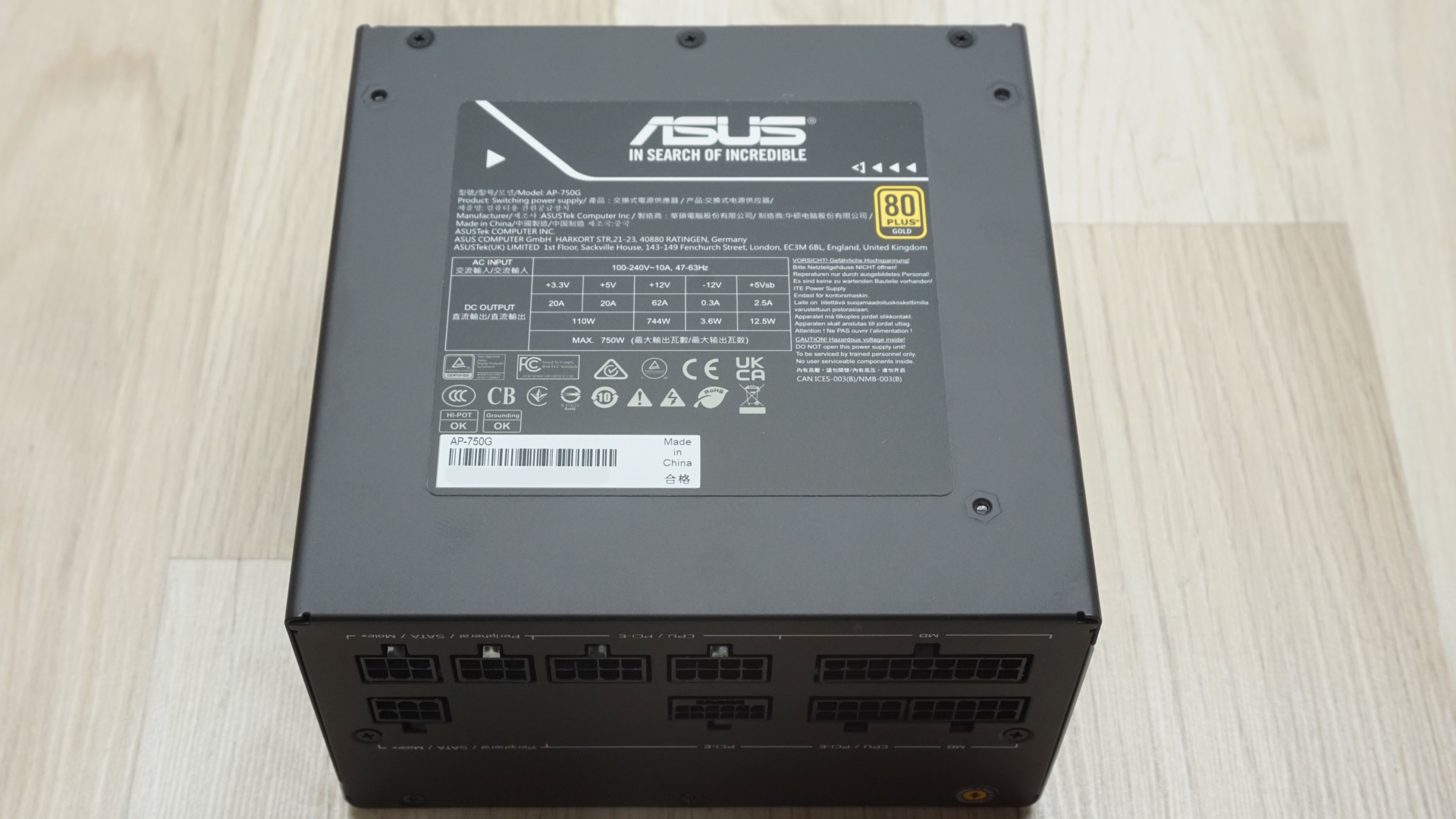
The Asus Prime AP-750G Gold 750W PSU is housed in a chassis that measures 150 mm in length, slightly longer than the standard ATX dimensions specified by the ATX design guide. This slight increase in length accommodates the 135 mm cooling fan, improving thermal management and acoustics without compromising compatibility with most ATX-compliant cases.
The unit features a unique dual-tone design, with the bottom and left half painted white and the remaining sections in black, allowing users to select between a predominantly white or black appearance based on the mounting orientation. Keep in mind however that the front of the unit will always be white and the rear will always be black. The aesthetic design is further complemented by a smooth matte finish, with discreetly etched Asus and series logos on the sides, offering a clean and refined look.



On the top side, a sticker details the electrical specifications and certifications, while the fan guard - integrated into the chassis - features a distinctive parallel line design, combining functionality with unique aesthetics. We do have our concerns that this kind of cutout could increase aerodynamic noise but that will be established during our testing. The front side of the PSU includes the standard on/off switch and the AC cable receptacle. The rear side is equipped with modular cable connectors, with a subtle legend printed next to them.
Internal Design
The Asus Prime AP-750G Gold 750W PSU is equipped with a Power Logic PLA13525B12M 135 mm fan, featuring a dual ball bearing engine. This fan type is renowned for its durability and reliability, making it a sound choice for such a PSU. Dual ball bearing fans are known to be noisier at higher speeds but they excel in high-temperature environments and are practically unaffected by orientation. This fan has a modest maximum speed of 2000 RPM, which should be more than enough for a unit with that kind of efficiency and power output.
Get Tom's Hardware's best news and in-depth reviews, straight to your inbox.


The Asus Prime AP-750G Gold 750W PSU is produced by Channel-Well Technology (CWT), a seasoned Taiwanese OEM with a strong reputation in the power supply industry. CWT has a proven track record of designing and manufacturing mid-to-high-end PC power supplies, with numerous platforms in their arsenal and dozens of premium PSUs based on them currently in the market.
The Asus Prime AP-750G Gold 750W PSU is primarily based on well-established and dependable topologies. The unit features a modest input filtering stage with two Y capacitors, one X capacitor, and two filtering inductors, complemented by a glass fuse for rudimentary protection. The Active Power Factor Correction (APFC) circuit includes one rectifying bridge mounted on its own heatsink, with three MOSFETs and one diode being the active components. The designer is using two powerful MOSFETs (Great Power GP28S50) assisted by an enhancement MOSFET (SPN5003) to improve the platform’s low-load performance. An encased inductor and an Elite 470 μF capacitor are the passive components.






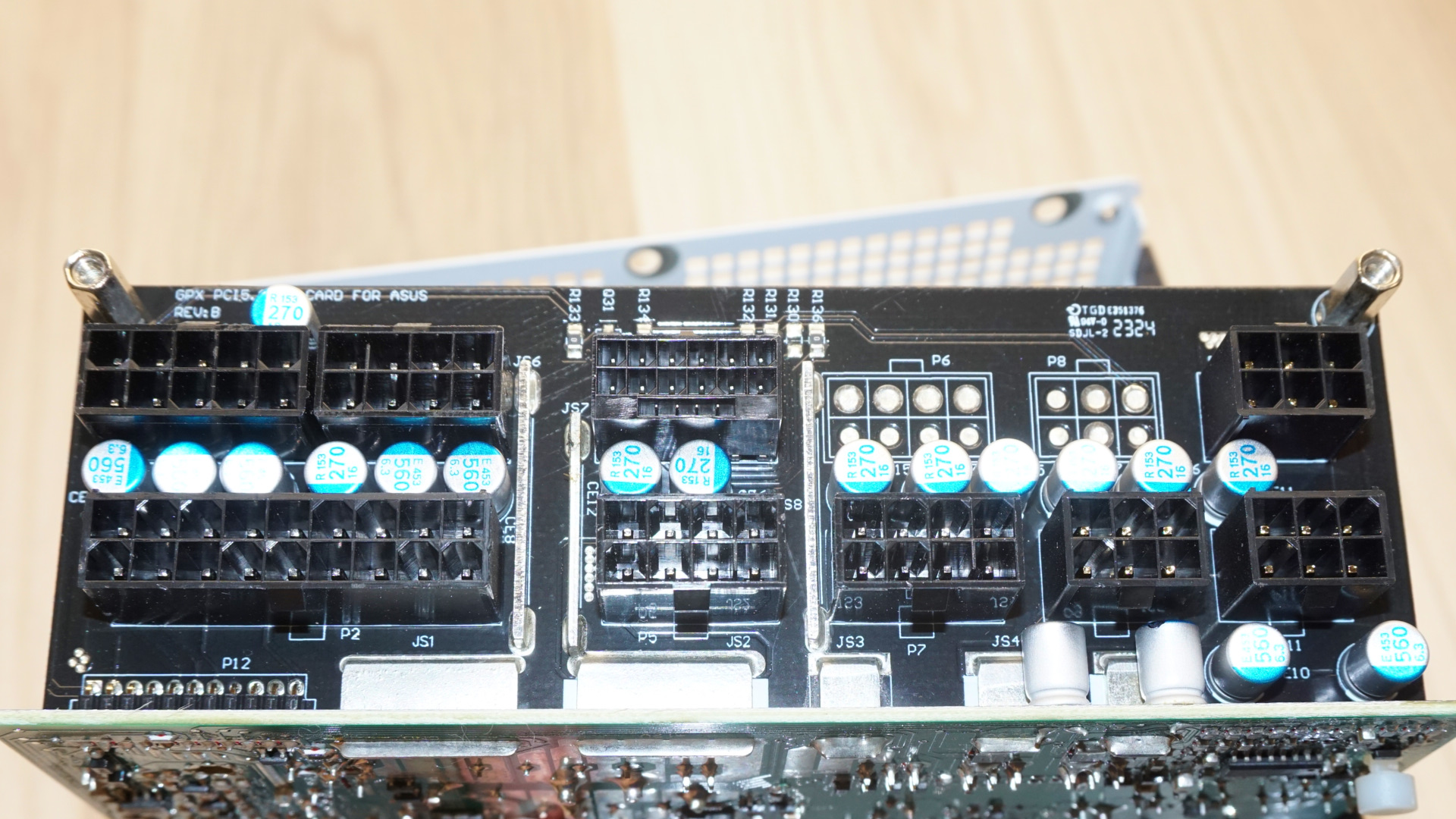

The primary inversion stage of the Asus Prime AP-750G Gold 750W PSU uses four SVF20N50F MOSFETs arranged in a full-bridge configuration. These MOSFETs are distributed across two heatsinks, with two MOSFETs and the APFC components sharing one heatsink, while the other two MOSFETs are on a smaller, separate heatsink. The secondary stage employs four Infineon 014N06NS MOSFETs located on the underside of the PCB to generate the primary 12V line, utilizing a synchronous rectification topology. The 3.3V and 5V rails are generated through DC-to-DC conversion on a vertical daughterboard. The capacitors on the secondary side are a mix of electrolytic and polymer types from Elite and Chinsan, both of which are established manufacturers but whose products we rarely find in premium PC PSUs.
Cold Test Results
Cold Test Results (25°C Ambient)
For the testing of PSUs, we are using high precision electronic loads with a maximum power draw of 2700 Watts, a Rigol DS5042M 40 MHz oscilloscope, an Extech 380803 power analyzer, two high precision UNI-T UT-325 digital thermometers, an Extech HD600 SPL meter, a self-designed hotbox and various other bits and parts.

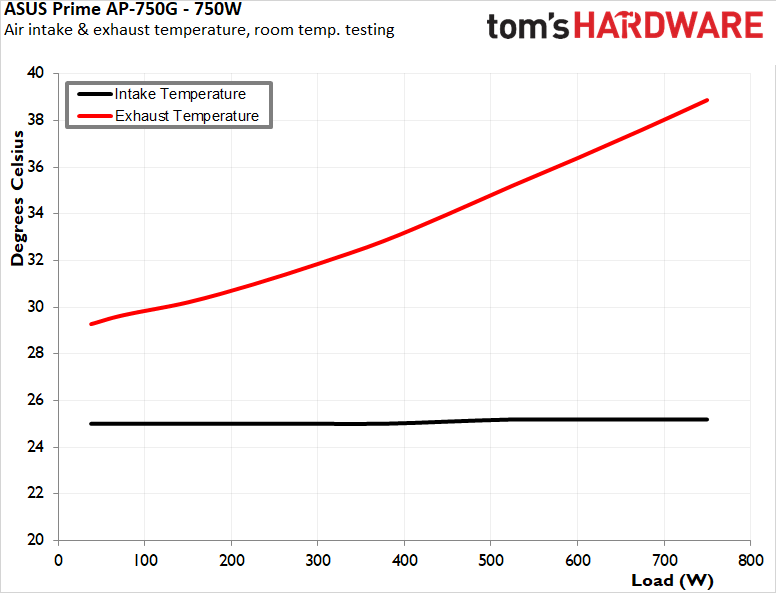
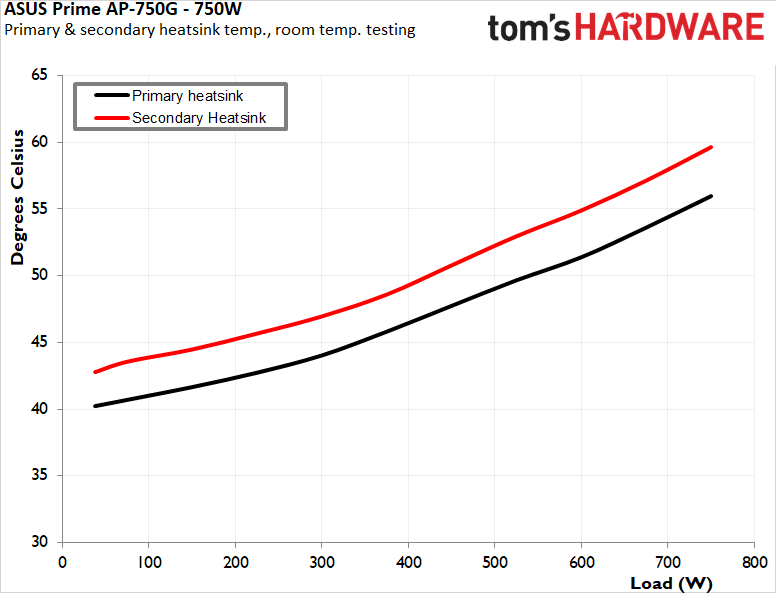


During cold testing, the Asus Prime AP-750G Gold 750W PSU easily meets the 80Plus Gold certification requirements regardless of the input voltage. When tested with a 115 VAC input, the PSU achieves an average nominal load efficiency of 89.4%, which improves to 91.2% when using a 230 VAC input. The efficiency of the unit peaks at approximately 50% of its capacity, the expected peak point of most PC PSUs topologies. At very low loads, the PSU maintains acceptable efficiency, though there is room for improvement, with the efficiency slightly dipping below expectations when the load is minimal.
The Asus Prime AP-750G Gold 750W PSU has its fan operating at all times but remains quiet across most of the load range. In our testing, the fan was generating minimal noise until the load exceeded 600 Watts. Beyond this point, the fan speed doubled, indicating a sharp approach to thermal management under increasing load. Even when the load is pushed higher, the fan does not reach its maximum speed, as the PSU’s internal temperatures remain within safe limits, balancing reliability and acoustics effectively.
Hot Test Results
Hot Test Results (~45°C Ambient)
During hot testing, the Asus Prime AP-750G Gold 750W PSU exhibits a measurable decrease in efficiency under heavy loads, with recorded figures of 88% at 115 VAC and 89.8% at 230 VAC, compared to 89.4% and 91.2% during cold testing. This reduction in efficiency is expected and occurs almost uniformly across the entire load range. Despite the significant decrease in efficiency, there are no signs of thermal stress, even when the PSU is pushed to its maximum load. Asus does not clearly indicate if the unit is rated at an ambient temperature 50°C but our testing revealed that it maintains stable operation at maximum power output under hot testing conditions.





In these hotter ambient conditions, the fan of the AP-750G expectedly activates earlier than during cold testing, with its speed increasing more rapidly as the load exceeds 300 Watts. However, the fan never reaches its maximum speed, as the internal temperatures remain well within safe limits, an unexpectedly good demonstration of performance considering the rather poor heatsinks this unit has. This thermal management strategy balances acoustic comfort with reliability, maintaining reasonable noise levels regardless of the operating conditions.
PSU Quality and Bottom Line
Power Supply Quality
The Asus Prime AP-750G Gold 750W PSU offers respectable electrical performance, but with some areas that could be improved. Voltage regulation is perhaps the highlight of this platform’s performance. The 12V rail maintains a regulation of 0.9%, which is by all means great, while the 5V and 3.3V lines show even better regulation at 0.5% and 0.7%, respectively.
| Load (Watts) | 150.92 W | Row 0 - Cell 2 | 376.6 W | Row 0 - Cell 4 | 561.42 W | Row 0 - Cell 6 | 747.88 W | Row 0 - Cell 8 |
| Load (Percent) | 20.12% | Row 1 - Cell 2 | 50.21% | Row 1 - Cell 4 | 74.86% | Row 1 - Cell 6 | 99.72% | Row 1 - Cell 8 |
| Row 2 - Cell 0 | Amperes | Volts | Amperes | Volts | Amperes | Volts | Amperes | Volts |
| 3.3 V | 1.81 | 3.34 | 4.53 | 3.34 | 6.8 | 3.33 | 9.07 | 3.32 |
| 5 V | 1.81 | 5.02 | 4.53 | 5.02 | 6.8 | 5 | 9.07 | 4.99 |
| 12 V | 11.25 | 12.07 | 28.11 | 12.05 | 42.17 | 11.97 | 56.23 | 11.96 |
| Line | Regulation (20% to 100% load) | Voltage Ripple (mV) | Header Cell - Column 3 | Header Cell - Column 4 | Header Cell - Column 5 | Header Cell - Column 6 | Header Cell - Column 7 |
|---|---|---|---|---|---|---|---|
| Row 0 - Cell 0 | Row 0 - Cell 1 | 20% Load | 50% Load | 75% Load | 100% Load | CL1 12V | CL2 3.3V + 5V |
| 3.3V | 0.70% | 10 | 16 | 20 | 22 | 20 | 16 |
| 5V | 0.50% | 8 | 12 | 16 | 24 | 18 | 18 |
| 12V | 0.9% | 26 | 20 | 36 | 54 | 50 | 32 |
Ripple suppression is adequate, with maximum ripple values of 54 mV for the 12V line, 24 mV for the 5V line, and 22 mV for the 3.3V line. These values are very well within the design guide recommendations but fall short of what most premium units achieve. There is definitely room for improvement, as these figures do not particularly stand out in the competitive PSU market, where tighter regulation is often expected.
During our thorough assessment, we evaluate the essential protection features of every power supply unit we review, including Over Current Protection (OCP), Over Voltage Protection (OVP), Over Power Protection (OPP), and Short Circuit Protection (SCP). The Asus Prime AP-750G Gold 750W PSU successfully passed all critical protection tests without issue.
The OCP settings for the 3.3V and 5V rails are well-calibrated, activating at 126%, which is slightly higher than average but ensures ample protection without being overly sensitive. The 12V rail’s OCP activation at 118% is very sharp for an ATX 3.0 unit, which might cause it triggering if the unit is operating at its limit and with a graphics card demanding severe power excursions. Notwithstanding, powering a very power-hungry card such as an RTX 4080/4090 with a 750W PSU is not recommended.
Bottom Line
The Asus Prime AP-750G Gold 750W PSU is a solid, yet not remarkable, entry in the mid-range power supply market. It is based on a well-established platform from Channel-Well Technology (CWT), demonstrating the reliability and performance expected from a seasoned OEM. However, while the platform itself is dependable, Asus's choice of components raises some concerns about long-term durability and performance consistency. The use of electrolytic and polymer capacitors from manufacturers like Elite and Chinsan, rather than more premium brands, suggests a compromise in component quality.
One of the strengths of the Asus Prime AP-750G Gold 750W PSU is its efficiency. The unit easily meets the 80Plus Gold certification, offering solid performance at both 115 VAC and 230 VAC inputs. The efficiency peaks at around 50% load, which is typical for most PSUs. While the efficiency at low loads is acceptable, it could be better, yet it is unlikely that this unit will be used to power systems that can bring their idle energy consumption this low. The fan operates quietly under most conditions, only becoming noticeably louder when the load exceeds 600 Watts. Even under heavy load and in an adverse operating environment, the fan never reaches its maximum speed, as the thermal losses of the unit do not warrant it.
In hot testing conditions, the PSU exhibits a slight but expected decrease in efficiency, and the fan activates earlier and increases speed more rapidly. Despite these conditions, the internal temperatures remain within safe limits, demonstrating the unit’s ability to maintain reliable operation even under stress.
When it comes to electrical performance, the Asus Prime AP-750G Gold 750W PSU offers good voltage regulation, particularly on the 5V and 3.3V rails. However, ripple suppression, while adequate, does not stand out compared to other units in the same price range. On the positive side, the PSU includes a comprehensive set of protection features, and it successfully passed all critical protection tests. The 8-year warranty is a strong point, offering buyers peace of mind and reflecting Asus's confidence in the product.
Priced at $100, the Asus Prime AP-750G Gold 750W PSU is reasonably positioned for an ATX 3.0 compliant unit. While it may not be the top choice for users seeking the highest performance or the best component quality, it offers a good balance of features, efficiency, and reliability, making it a viable option for mainstream users and gamers who need a reliable power source at a fair price.
MORE: Best Power Supplies
MORE: How We Test Power Supplies
MORE: All Power Supply Content

Dr. E. Fylladitakis has been passionate about PCs since the 8088 era, beginning his PC gaming journey with classics like Metal Mutant and Battle Chess. Not long after, he built his first PC, a 486, and has been an enthusiast ever since. In the early 2000’s, he delved deeply into overclocking Duron and Pentium 4 processors, liquid cooling, and phase-change cooling technologies. While he has an extensive and broad engineering education, Dr. Fylladitakis specializes in electrical and energy engineering, with numerous articles published in scientific journals, some contributing to novel cooling technologies and power electronics. He has been a hardware reviewer at AnandTech for nearly a decade. Outside of his professional pursuits, he enjoys immersing himself in a good philosophy book and unwinding through PC games.
-
Co BIY Thanks for the review.Reply
I think some expert commentary regarding the use cases for this 750 watt level as opposed to higher or lower and when someone should consider going to the "higher lines" would be a welcome addition.
Is anyone actually conducting tests on capacitors that indicate that the Premium Japanese manufacturers are still providing a better product in 2024 ? It been twenty years since the capacitor plague. -
derekullo 80 Plus - I'd like this place to burn down.Reply
80 Plus Bronze - I'd like this place to burn down while attempting to point the finger away from me.
80 Plus Silver - Not good enough for gold. Not guaranteed to burn your house down. You won't see many of these.
80 Plus Gold - Minimum for a not burn your house down / gaming build. Very noisy.
80 Plus Platinum - Good quality power efficient parts allows for near silent operation.
80 Plus Titanium - Excellent build quality. Extremely quiet. Will outlast GPU. -
Co BIY Replyderekullo said:80 Plus - I'd like this place to burn down.
80 Plus Bronze - I'd like this place to burn down while attempting to point the finger away from me.
80 Plus Silver - Not good enough for gold. Not guaranteed to burn your house down. You won't see many of these.
80 Plus Gold - Minimum for a not burn your house down / gaming build. Very noisy.
80 Plus Platinum - Good quality power efficient parts allows for near silent operation.
80 Plus Titanium - Excellent build quality. Extremely quiet. Will outlast GPU.
I don't think 80 Plus ratings measure anything more than straight up efficiency in few designated ranges . -
derekullo Reply
True but to meet those lower efficiency ratings they use lower quality/cheaper parts which have a tendency to best case fail or worst case start a fire.Co BIY said:I don't think 80 Plus ratings measure anything more than straight up efficiency in few designated ranges .
A PSU having lower energy efficiency such as 80 Plus, means that on average that PSU will not last as long as a higher efficiency part like an 80 Plus Gold, Platinum or Titanium.
Heat is the enemy of electronics and so the cooler you can make them run the longer they will last.
An 80 Plus rating literally means it will generate more heat than an equal wattage Gold or higher.
Something of higher quality like the Corsair AX1000 with its 80 Plus Titanium rating has a 10 year warranty showing that Corsair believes it will last at least 10 years.
For comparison the Thermaltake Litepower 750W ... aka the firestarter ... has a 2 year warranty with its 80 Plus rating. -
Hapilton Replyderekullo said:80 Plus - I'd like this place to burn down.
80 Plus Bronze - I'd like this place to burn down while attempting to point the finger away from me.
80 Plus Silver - Not good enough for gold. Not guaranteed to burn your house down. You won't see many of these.
80 Plus Gold - Minimum for a not burn your house down / gaming build. Very noisy.
80 Plus Platinum - Good quality power efficient parts allows for near silent operation.
80 Plus Titanium - Excellent build quality. Extremely quiet. Will outlast GPU.
This is so stupid I had to register just to point out how stupid it is. -
derekullo Reply
I agree.Hapilton said:This is so stupid I had to register just to point out how stupid it is.
Power supplies with such bad craftsmanship that they pose a danger to people and objects around them should not be sold to the public.
